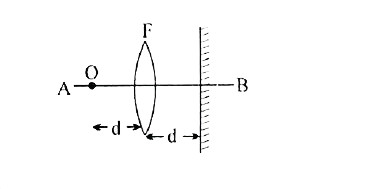A point object O moves from the principal axis of a converging lens in a direction OP. I is the image of O, will move initially in the direction
 Solution in Gujrati
Solution in Gujrati
The correct Answer is:C
_E01_033_S01.png)
(i) vIx=m2v0x (same direction)
(ii) ∵ m = -ve , m=vu,
(v=-ve, u =+ve) then vIy = -ve
Topper's Solved these Questions
- GEOMETRICAL OPTICSBOOK - ALLEN CHAPTER - GEOMETRICAL OPTICSEXERCISE - EXERCISE-2
44 Videos
- GEOMETRICAL OPTICSBOOK - ALLEN CHAPTER - GEOMETRICAL OPTICSEXERCISE - EXERCISE-3
12 Videos
- GEOMETRICAL OPTICSBOOK - ALLEN CHAPTER - GEOMETRICAL OPTICSEXERCISE - EXERCISE - 05 (B) (ASSERTION & REASON )
9 Videos
- CURRENT ELECTRICITYBOOK - ALLEN CHAPTER - CURRENT ELECTRICITYEXERCISE - EX.II
66 Videos
- GRAVITATIONBOOK - ALLEN CHAPTER - GRAVITATIONEXERCISE - EXERCISE 4
9 Videos
Similar Questions
Two mirrors are inclined at angle θ as shown in figure. Light rays are incident parallel to one of mirrors. Light will start retracing its path after the reflection if
View SolutionPlane mirrors are arranged parallel to each other as shown in column-I and the number of images formed by the combination is in column- II
_E01_090_S01.png)
View SolutionStatement-1: The total translational kinetic energy of fall the molecules of a given mass of an ideal gas is 1.5 times the product of its pressure and its volume because.
Statement-2: The molecules of a gas collide with each other and the velocities of the molecules change due to the collision.
View SolutionIn the Bohr's model of hy drogen atom, the electron moves around the nucleus in a circular orbit of radius 5×10−11m. Its time period is 1.5×10−16s. The current associated with the electron motion is:-
View SolutionAssertion : The difference in the value of acceleration due to gravity at pole and equator is proportional to square of angular velocity of earth.
Reason : the value of acceleration due to gravity is minimum at the equator and maximum at the pole.
View SolutionAssertion : In case of a concave mirror if a point object is moving towards the mirror along its principal axis, then its image will move away from the mirror. Reason : In case of reflection (along the principal axis of mirror) object and image always travel in opposite directions.
View SolutionAB is the principal axis of a spherical mirror. I is the point image corresponding to a point object O. Choose the correct opritons.

View SolutionO_1P is the principal axis and O is the point object. Given, O_1P=30cm, f=20cm and OP=2mm . Find the image distance and its position.
View SolutionAs an object is moved from the surface of a thin converging lens to a focal point, over what range does the image distance very?
View SolutionAn object is moving towards a converging lens on its axis. The image is also found to be moving towards the lens. Then, the object distance u must satisfy
View SolutionA point object 'O' is at the center of curvature of a concave mirror. The mirror starts to move at a speed u, iin a direction perpendicular to the principal axis. Then, the initial velocity of the image is
View SolutionA point object (O) lies at a distance of 20 cm on the principal axis of a convex lens of focal length f = 10 cm . The object begins to move in a direction making an angle of 45° with the principal axis. At what angle with the principal axis does the image beings to move?
View SolutionIn the figure shown ‘O’ is point object. AB is principal axis of the converging lens of focal length F. Find the distance of the final image from the lens.

View SolutionWhen the object is moved slightly closer to a converging lens, the image may
View SolutionA point object moves along the principal axis of a convex lens of focal length f such that its real image, also formed on the principal axis at a distance (4f)/(3) (at t=0) moves away from the lens with uniform velocity alpha . Find the velocity of the point object as a function of time t.
View SolutionAssertion : In case of a concave mirror if a point object is moving towards the mirror along its principal axis, then its image will move away from the mirror. Reason : In case of reflection (along the principal axis of mirror) object and image always travel in opposite directions.
View Solution
